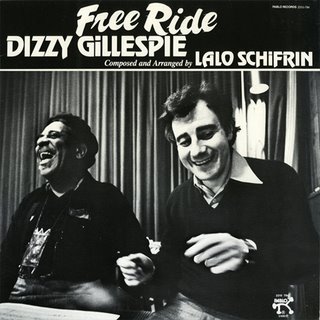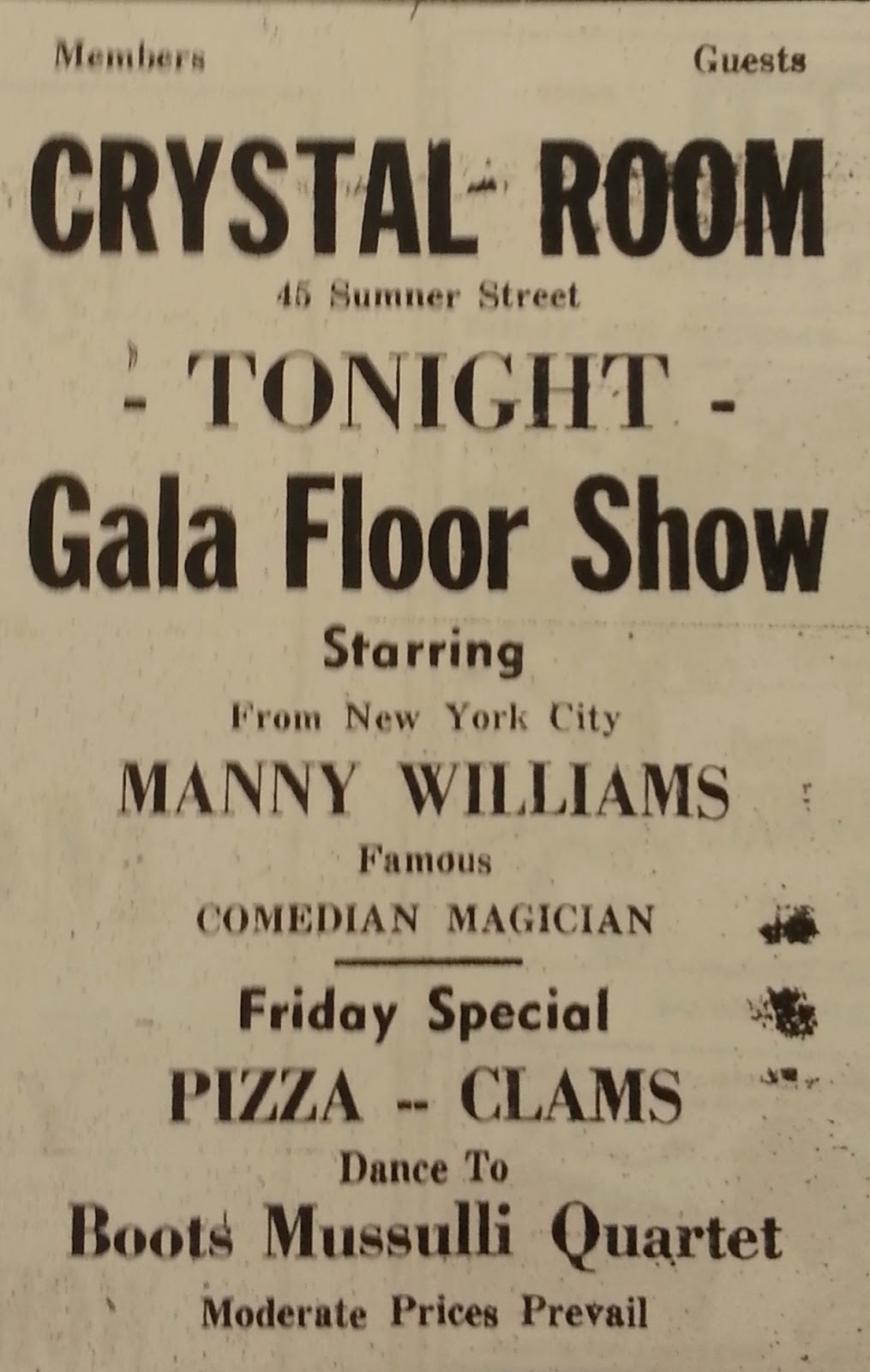By David "Chet" Williamson Sneade
Growing up in Worcester
After all, Milford Crystal Room
 |
| Downtown Milford, circa early 1960s |
Trying to bring into focus and document life from years gone by is
a little like asking the wind to be still. Separating cleared-eyed memory from
second-hand assumptions becomes a daunting task as time slips away.
“That which we do is what we are. That which we remember is, more often than not, that which we would like to have been, or that which we hope to be. Thus our memory and our identity are ever at odds, our history ever a tall tale told by inattentive idealists.” – Ralph Ellison from Golden Age, Time Past
Nevertheless, what little recorded history we have, coupled with
the collective memory of those fortunate enough to have experienced the Crystal Room in person, gives us a
portrait of a mythical place deserving of the appellation: Jazz Mecca.
Consider the established names who played there and those who came
of age on its bandstand. Here’s the Who’s Who of some of its headliners: Duke
Ellington, Count Basie, Lionel Hampton, Woody Herman, Harry James, Charlie
Barnet, Dizzy Gillespie, George Shearing, the Four Freshmen, Serge Chaloff, and
Carmen McRae. A partial list of the supporting cast and local musicians
includes Dave McKenna, Emil Haddad, Ziggy Minichiello, Al Cass, Chick Eddy, Joe
Holovnia, Bob Varney, Tony Chick, John Acaro, Paul Drummond, and Sonny Dee.
The Crystal Room was located in the
lower level of the Sons of Italy Hall at 45 Sumner Street, Milford .
The upstairs hall was reserved for weddings, anniversaries, private parties,
and other social functions.
 |
| The original entrance to the Crystal Room |
Today, the new building is the home of THAT Corporation, a Milford-based company that designs and manufactures high quality audio technology in the form of integrated circuits, licensed intellectual property, and semiconductor fabrication. THAT’s owners are well aware of the structure’s history and the
 |
| Inlay in the Sons of Italy floor |
Originally from Waltham, where the company was founded, Travaline was approached by countless people
from the Milford
 |
| Travaline describing the hall |
 |
| Travaline entering the hall |
To pay homage, the company purchased a collection of rarely seen
photos taken by the late Al Tomaso of the musicians who plied their trade at
the Crystal Room .
Now
blown-up and handsomely framed, the pictures capture some the best musicians
that America ever
produced in action. Boots Mussulli is the star attraction, and in one frame
he’s seated at the piano with Duke Ellington looking on.
Other photos include
those of a young Maynard Ferguson in full flight. There’s Dizzy Gillespie’s
quintet with guitar legend Les Spann. Count Basie looks as regal as ever.
That’s Carmen McRae in her early days. One of most talked about photos in the
series is one of Lionel Hampton standing on top of a patrons’ table while
tapping his drumstick on one of the hall's light fixtures hanging from the
ceiling.
Tomaso’s stills bring the Crystal Room
The above shot is the only known published photo by Tomaso that also appears on the Crystal Room wall. It was first published in the Worcester Telegram and later in the Middlesex News.
 |
| Mussulli at the piano with Ellington by Tomaso, courtesy of Steve Minichiello |
The above shot is the only known published photo by Tomaso that also appears on the Crystal Room wall. It was first published in the Worcester Telegram and later in the Middlesex News.
The Crystal Room
For more on THAT see: http://www.thatcorp.com/
Mussulli’s involvement with the establishment
goes way back. He and his family were members of the Sons of Italy. Almost from
beginning he played and produced shows there, long before he was formally
involved with booking the room. In fact, early advertisements show him in
performance at the hall with his various groups. The Tomaso photographs are
dated from 1948 to 1967. (The photographer died in 2009.) The highest
concentration of shows occurred in the late ‘50’s and early ‘60’s.
Some of the more memorable early shows include
appearances by Charlie Parker. In two published ads, trumpeter Red Rodney, who
played with Bird between 1949 and ’52, is listed with the band. Other
accounts of Birdlore say that Parker played in Milford
Other early Crystal Room
As aforementioned, by the late ‘50s, Mussulli
had left the road and concentrated on local teaching, playing, and freelance
work with a variety of big bands, most notably Herb Pomeroy’s Boston-based
orchestra. By 1959, Boots with the assistance of Leo Curran, a longtime friend
and fellow Milford Crystal Room Milford Crystal
 |
| Worcester drummer Bobby Gould and Mussulli at the Crystal, courtesy of Ken Sawyer |
In a 2003 interview with Curran, the former road manger for Stan Kenton said, “We had
everybody at the Crystal Room
"I remember one
night at Boots Mussulli house having a spaghetti dinner with Charlie Parker.
Bird had a huge appetite. Unreal. He was telling Boots. Don’t do the drug thing
man, man. Smoke a little grass. You know, man you can’t play when you do that.
Here’s the genius of the alto saxophone telling another saxophonist not to do
the drug thing."
Curran also recalled, the Crystal Room as being, "a
"Abe Kurchin,
who was Woody Herman’s manager called once saying, ‘Man, I got Monday night open.’ I
said, ‘What kind of bread you want?’ He says, 'Gas money.' I said, 'What’s gas
money.' He says, '$500.' I said, '$400 and a
meal.' He said, 'For the whole band?' I said, 'Yes. He said, ‘Good deal. We’ll go for
it.’"
 |
| Young Ken Sawyer with Lionel Hampton |
“He had stuff going just about every week,
sometimes a couple of times a week. I know I saw the contracts because I was
the secretary of the Milford
When asked to describe the Crystal Room Crystal Room
In the early days the only piano was an old
upright. “They had a baby grand later,” Sawyer said. “Lalo Schiffrin, who was
with Dizzy Gillespie, played the upright. I watched for the first time an
upright rock back and forth when he played it.”
Sawyer was a programmer at Milford Crystal Room 8:30-9 p.m. I’d get permission from the musician’s union.
We couldn’t pay them so I’d have to get permission from the leader of the band.
I would talk to Harry James before the broadcast and say, ‘Do you mind? We are
going to broadcast live over a local station. Is it okay with you guys?’
“I remember a couple of times I had to sell
the ‘sandwich special of the night’ before introducing Harry James. He
impressed me a lot because they all had their instruments up to their mouths
and ready. As soon as I announced: ‘The Harry James Orchestra,’ Wham! They hit
it. Harry James and Count Basie were the two most radio-conscious bandleaders.”
Unfortunately, none of WMRC shows were
captured on tape – at least none have surfaced. “They were all live
broadcasts,” Sawyer said. “None were professionally recorded, but musician
Bunny Calabrese made his own LP of the Count Basie concert. I know, because he
called me up and wanted to know if I wanted to hear myself on record.”
In describing the layout of the hall, Sawyer
recalled, “You’d get your tickets outside and go down into the Crystal Room
When asked about the sound, Sawyer said, “The
sound system was always good there. I would have a microphone. It would not be
like nowadays with five or six microphones on stage. Certain bands would come
with their own engineer.”
“The Crystal Room Boston Boston
“Boots rented the hall. It wasn’t easy doing
jazz. Even then. There were times when he would take a bath. You have to
consider that they were off nights, like Tuesdays. Boots not only did the
nightclub concerts, but he also did the daytime kid’s concerts. It would be
like on a Sunday afternoon and he would hire a rock band and a jazz band. One
time he had Charlie Ventura’s trio with Dave McKenna on piano and a rock band.”
Sawyer not only emceed shows, but being a
working musician, he also had the good fortune to play the Crystal Room
“I saw Serge when he was in a wheelchair. His
body was wilting, you could see how weak he was, but he still played great.
Boots had booked the thing because he knew that Serge was on the way out. They
were great friends and had played together. He is my favorite saxophonist. I
had the pleasure of talking with Serge that night. It was his quartet or trio?
Ray Santisi played piano. Jimmy Zitano, the drummer…. Fantastic.”
Sawyer says he wasn’t around for the club’s
demise. “I got married in ’66, and before that I was out gigging around. Boots
died in ’67, but, the ‘hey day’ of the Crystal
 |
| Written in Mussulli's handwriting, courtesy of Ken Sawyer |
Given the opportunity to walk through these
hallowed halls chasing the jazz ghosts of yesteryear reminds one of how
important it is to honor these humble shrines, and to recognize that this is
our heritage.
Long live the legacy of the Crystal Room
*Note: This is a work in
progress. Comments, corrections, and suggestions are always welcome at:walnutharmonicas@gmail.com. Also see: www.worcestersongs.blogspot.com Thank you.


















































.jpg)


Chet, this is another amazing piece. Your writing is so well researched and the photos, newspaper ads and articles, broadsides, etc. are a treasure to see.
ReplyDeleteThanks for all your hard work and for your generosity in sharing your work with our whole jazz community!
Rich
It is a truly remarkable thing that you have achieved. You should be very proud of yourselves
ReplyDeletecrystal saxophone
Great page - I lived in Milford around '75, and played piano with Ken Sawyer, and his wife (singer) Mary Lou around that time. I didn't know much about his background, so what a find! Thanks!
ReplyDeleteMark Borgmann